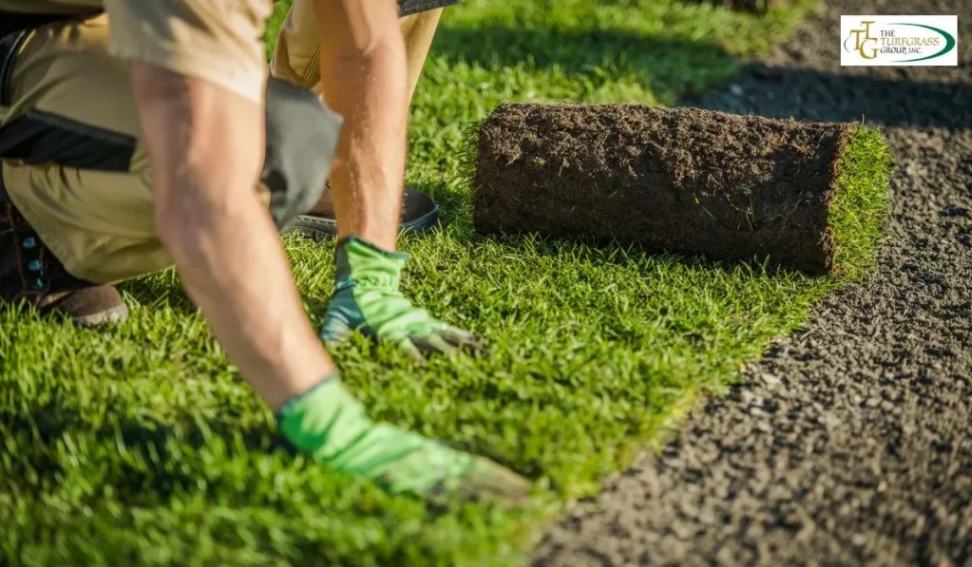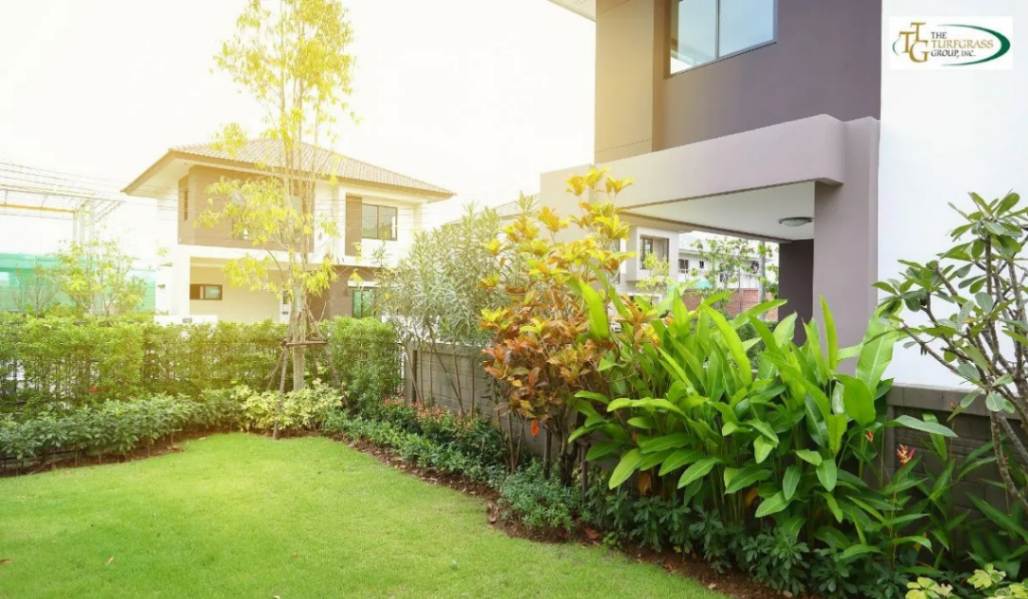
Creating a lush, green lawn is a dream for many homeowners.
The foundation of that dream lies in choosing the right type of turf grass.
Different types of turf grass come with unique characteristics, maintenance needs, and aesthetic appeal.
In this comprehensive guide, we’ll explore seven popular types of turf grass for home lawns.
Each type will be examined for its suitability based on climate, maintenance requirements, and overall performance.
This way, you can make an informed choice for your lawn.
Kentucky Bluegrass
Kentucky Bluegrass is a classic choice for homeowners in northern climates.
This grass type is celebrated for its rich, vibrant green color and lush texture.
It thrives in cooler temperatures and is well-suited for regions that experience cold winters.
Characteristics
Kentucky Bluegrass has a fine texture, making it soft and pleasant underfoot.
One of its remarkable features is its ability to self-repair.
It spreads through underground rhizomes, allowing it to fill in bare spots naturally.
Benefits
- Aesthetic Appeal: The deep green color and dense growth create a beautiful lawn.
- Self-Repairing: Its rhizomatic growth helps maintain a full lawn even after wear and tear.
Maintenance
Kentucky Bluegrass requires consistent maintenance:
- Watering: Regular watering is crucial, especially during dry spells. This grass prefers moist conditions.
- Fertilization: Fertilizing in spring and fall can enhance growth and color.
- Mowing: Regular mowing is essential to maintain its appearance and health.
Challenges
While it’s a popular choice, Kentucky Bluegrass has some challenges:
- Drought Sensitivity: It can struggle in drought conditions without adequate watering.
- Disease Susceptibility: Be vigilant against diseases like brown patch and dollar spot.
In summary, Kentucky Bluegrass is an excellent choice for homeowners seeking a lush lawn, provided they’re ready for its maintenance needs.
Tall Fescue
Tall Fescue is a versatile grass type that has gained popularity for its adaptability.
This type of grass is well-suited for transitional zones where temperatures vary widely.
Characteristics
Tall Fescue is known for its coarse texture and deep root system, which enables it to endure heat and drought.
It can handle a variety of soil types, making it a flexible option for many homeowners.
Benefits
- Drought Tolerance: Its deep roots allow it to access moisture, making it less dependent on frequent watering.
- Shade Tolerance: It performs well in partially shaded areas, unlike many other grass types.
Maintenance
Tall Fescue is relatively low-maintenance:
- Watering: Although drought-resistant, it benefits from occasional watering during extreme dry spells.
- Fertilization: Regular fertilization, especially in spring and early fall, promotes healthy growth.
- Mowing: It grows rapidly during warm months, requiring regular mowing to keep it at a desirable height.
Challenges
While Tall Fescue is hardy, it does have some drawbacks:
- Heat Sensitivity: In extreme heat, it may become stressed and require more water.
- Pest Issues: It can attract certain pests, so vigilance is necessary.
Overall, Tall Fescue is an excellent choice for those seeking a hardy, adaptable lawn with lower maintenance needs.
Perennial Ryegrass
Perennial Ryegrass is often the go-to option for quick lawn establishment.
It germinates rapidly, making it ideal for overseeding or quick patches in northern climates.
Characteristics
This grass type has a fine to medium texture and a rich green color.
Its quick establishment is one of its primary advantages, especially in cooler conditions.
Benefits
- Fast Germination: Perennial Ryegrass can germinate within 5 to 10 days, making it ideal for quick fixes.
- Aesthetic Value: Its lush green color and texture create an attractive lawn.
Maintenance
Maintenance for Perennial Ryegrass includes:
- Watering: Regular watering is essential, particularly during the establishment phase.
- Fertilization: Applying fertilizer in early spring and fall encourages robust growth.
- Mowing: Frequent mowing is necessary to keep the grass at an ideal height.
Challenges
Despite its many benefits, Perennial Ryegrass does have some downsides:
- Drought Sensitivity: It’s not as drought-resistant as some other grasses, requiring consistent moisture.
- Wear Tolerance: It can struggle under heavy foot traffic, so it’s best suited for low-traffic areas.
In summary, Perennial Ryegrass is ideal for homeowners who want a quick green lawn and are willing to maintain it closely.
Bermuda Grass

Bermuda Grass is a warm-season grass that thrives in southern climates.
It’s known for its durability and ability to withstand heavy foot traffic.
Characteristics
Bermuda Grass has a fine to medium texture and creates a dense lawn.
It grows vigorously in warm weather and can become quite aggressive if left unchecked.
Benefits
- Durability: Its ability to handle wear and tear makes it ideal for active families and sports fields.
- Quick Recovery: Bermuda Grass recovers rapidly from damage, making it a great choice for high-traffic areas.
Maintenance
While Bermuda Grass is resilient, it requires regular maintenance:
- Watering: Deep watering is essential during hot, dry spells.
- Fertilization: Fertilize in late spring to encourage vigorous growth.
- Mowing: Regular mowing helps control its aggressive growth and maintain a neat appearance.
Challenges
However, Bermuda Grass does have its challenges:
- Dormancy: It goes dormant and turns brown in cooler temperatures, making it less visually appealing in winter.
- Sunlight Requirements: It requires full sun for optimal growth and is not suitable for shaded areas.
If you live in a warm climate and have an active household, Bermuda Grass could be the perfect choice for your lawn.
Zoysia Grass
Zoysia Grass is another popular option for homeowners in warm climates.
It’s known for its thick, carpet-like texture and resilience.
Characteristics
Zoysia Grass has a medium to fine texture and is appreciated for its dense growth.
It’s slow to establish but forms a sturdy turf once it takes root.
Benefits
- Drought Resistance: Zoysia Grass is highly drought-resistant, making it a smart choice for areas with limited rainfall.
- Shade Tolerance: It performs well in partially shaded areas, allowing for versatility in lawn placement.
Maintenance
Zoysia Grass requires moderate maintenance:
- Watering: Although drought-resistant, it should be watered during prolonged dry periods.
- Fertilization: Regular fertilization promotes healthy growth, particularly in the spring.
- Mowing: Its slower growth rate means less frequent mowing compared to other grass types.
Challenges
Despite its many benefits, Zoysia Grass has some challenges:
- Slow Establishment: It takes longer to establish compared to other grasses, requiring patience.
- Pest Susceptibility: Zoysia can attract certain pests, so it’s important to monitor for issues.
Overall, Zoysia Grass is a great option for those who want a resilient and attractive lawn with moderate care requirements.
Fine Fescue
Fine Fescue is a collection of grasses, including creeping red fescue, chewings fescue, and hard fescue.
These grasses are particularly well-suited for cooler climates and shaded areas.
Characteristics
Fine Fescue is known for its fine texture and dense growth habit.
It thrives in cool, moist environments and is often used in seed mixtures for lawns.
Benefits
- Shade Tolerance: It excels in shady conditions, making it ideal for lawns with trees.
- Low Maintenance: Fine Fescue requires less mowing and watering than many other grass types.
Maintenance
Maintenance for Fine Fescue is relatively straightforward:
- Watering: It generally requires less frequent watering due to its drought tolerance.
- Fertilization: Minimal fertilization is needed; a light application in spring is usually sufficient.
- Mowing: Occasional mowing helps maintain its appearance.
Challenges
However, Fine Fescue does have some limitations:
- Traffic Tolerance: It is not as tolerant of heavy foot traffic, making it best for low-traffic areas.
- Establishment Time: It can take longer to establish compared to quicker germinating grasses.
In summary, Fine Fescue is an excellent choice for shaded areas and low-maintenance lawns.
Buffalo Grass
Buffalo Grass is a native warm-season grass that thrives in dry, arid climates.
It’s an excellent choice for homeowners looking for an environmentally friendly, low-maintenance lawn.
Characteristics
Buffalo Grass has a fine texture and forms a dense, resilient turf.
It’s known for its ability to withstand heat and drought, making it ideal for areas with limited rainfall.
Benefits
- Drought Tolerance: Buffalo Grass requires minimal watering, making it an eco-friendly option.
- Low Maintenance: It grows slowly and requires less frequent mowing and fertilization.
Maintenance
While Buffalo Grass is low maintenance, it does have some needs:
- Watering: Watering should be done sparingly, particularly during establishment.
- Fertilization: Minimal fertilization is required; too much can be detrimental.
- Mowing: Occasional mowing keeps it neat but isn’t needed as often as other grasses.
Challenges
Despite its many benefits, Buffalo Grass does have some challenges:
- Slow Establishment: It takes time to establish and fill in, so patience is needed.
- Sunlight Requirements: Buffalo Grass thrives in full sun, making it unsuitable for shaded areas.
For homeowners seeking a sustainable, low-maintenance lawn, Buffalo Grass is an excellent option.
Conclusion
Choosing the right type of turf grass for your home lawn is a significant decision that impacts the beauty and functionality of your outdoor space.
Different types of turf grass offer various advantages, from aesthetic appeal to resilience against heat and drought.
By understanding the unique characteristics and requirements of these seven popular grass types—Kentucky Bluegrass, Tall Fescue, Perennial Ryegrass, Bermuda Grass, Zoysia Grass, Fine Fescue, and Buffalo Grass—you can make an informed choice that suits your specific needs.
With the right selection and proper care, your lawn can become a beautiful and inviting part of your home for years to come.
FAQs
What is the best turf grass for a shaded area?
Fine Fescue is often recommended for shaded areas due to its excellent shade tolerance and fine texture.
How often should I water my lawn?
Watering frequency depends on the grass type and climate. Generally, deep watering once or twice a week is recommended for optimal health.
Can I mix different types of turf grass?
Yes, mixing different types of turf grass can create a more resilient lawn, especially in transitional climates, allowing you to take advantage of their unique strengths.